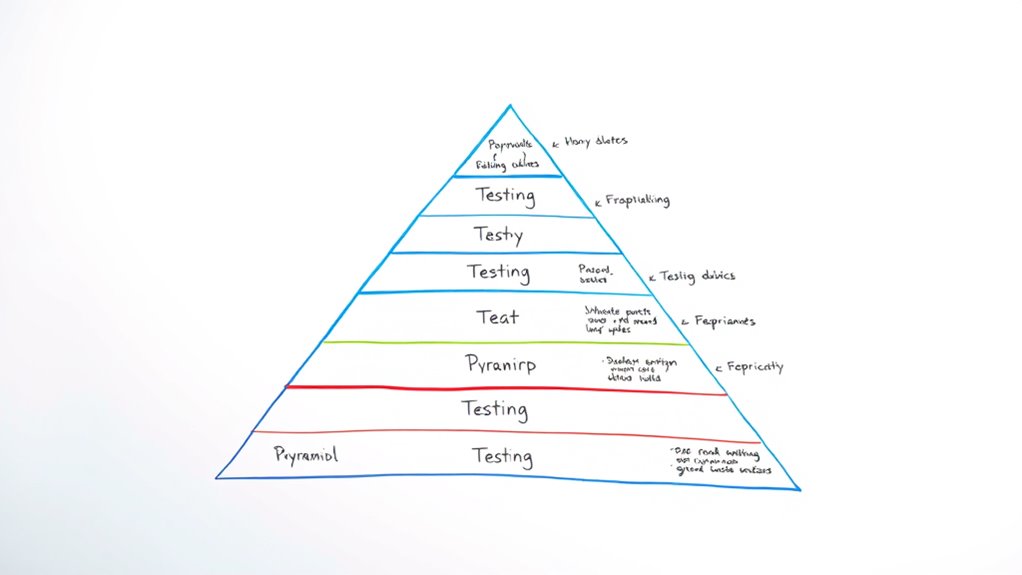The test pyramid remains a crucial framework for organizing effective testing, helping you prioritize quick, inexpensive tests at the base and reserve complex tests for the top. Its relevance depends on your team’s skills in automation, as well as your ability to adapt practices for modern CI/CD workflows. If you focus on building automation expertise and updating your testing approach, you’ll access the full benefits of the pyramid—more efficient testing and higher software quality. Keep going to explore how to make it work for you.
Key Takeaways
- The test pyramid remains relevant as it promotes efficient testing by emphasizing faster, cheaper tests at the base.
- Successful implementation depends on teams developing automation skills and adopting best practices for reliable unit tests.
- Properly executed, the pyramid supports rapid feedback in modern CI/CD workflows, enhancing software quality.
- Over-reliance on end-to-end tests can undermine its benefits; balanced testing efforts are essential.
- Investing in team training and fostering a testing culture ensures the pyramid continues to be a valuable testing strategy.

The test pyramid remains a fundamental concept in software testing because it helps teams prioritize their testing efforts for maximum efficiency. It encourages you to focus on faster, cheaper tests at the base, such as unit tests, and reserve more complex, slower tests—like end-to-end tests—for the top. This approach minimizes automation challenges by reducing the amount of flaky or brittle tests that can slow down your development cycle. However, implementing this pyramid isn’t without its hurdles. One common obstacle is the skill gap within your team. Not everyone may be comfortable writing or maintaining automated unit tests, which can lead to inconsistent test coverage or reliance on manual testing. If your team’s skills are lacking in areas like automation frameworks or test design, you might struggle to realize the full benefits of the test pyramid.
To address these automation challenges, you need to invest in training and continuous learning. Equipping your team with the right skills ensures they can write reliable, maintainable tests that genuinely reflect the code’s behavior. Incorporate best practices for writing unit tests early on, and foster a culture where testing is seen as a crucial part of the development process rather than an afterthought. When your team is confident in their testing skills, you’ll find it easier to automate effectively, reduce false positives, and catch bugs sooner. This, in turn, enhances the overall quality of your software and accelerates delivery timelines. Additionally, understanding test automation and its principles is essential for scaling testing efforts effectively across projects.
Invest in training and foster a testing culture to improve automation and software quality.
Furthermore, the relevance of the test pyramid depends heavily on your project’s context. Modern development practices, such as continuous integration and delivery (CI/CD), demand rapid feedback loops that the pyramid supports well—if properly implemented. However, if your team lacks experience with automated testing tools or struggles to integrate tests into the CI/CD pipeline, the effectiveness diminishes. You may end up with overly reliant end-to-end tests, which are slower and more fragile, defeating the purpose of the pyramid.
Ultimately, the test pyramid remains relevant because it provides a clear, structured approach to testing that balances speed, cost, and coverage. But to truly harness its power, you need to address automation challenges head-on and bolster your team’s skills. When you do so, you’ll discover that the pyramid isn’t just a theoretical model; it becomes a practical tool that streamlines your testing process, improves quality, and enables faster releases. The key is continuous learning, adapting, and ensuring your team is equipped to embrace automation confidently.
Frequently Asked Questions
How Does the Test Pyramid Apply to Microservices Architecture?
You should apply the test pyramid to microservices architecture by focusing on service isolation, ensuring each microservice is tested independently. Use a solid base of unit tests for quick feedback, middle-tier integration tests to verify service interactions, and fewer end-to-end tests for overall deployment strategies. This approach helps catch bugs early, supports continuous delivery, and maintains flexibility, making your microservices more reliable and easier to deploy and scale.
What Are Alternatives to the Traditional Test Pyramid Model?
Imagine your tests as a safety net, but the traditional test pyramid isn’t the only pattern. Instead, you can adopt a layered approach emphasizing rapid unit testing and extensive test automation at the API and UI levels. This alternative focuses on continuous feedback and resilience, allowing you to catch issues early without adhering strictly to the classic pyramid. It’s about flexibility, speed, and adapting testing strategies to modern development needs.
How Do Continuous Integration Practices Influence the Test Pyramid?
Continuous integration practices greatly influence the test pyramid by emphasizing frequent test automation within deployment pipelines. As you integrate code continuously, you need a solid foundation of unit tests to catch issues early, supported by automated integration tests and fewer end-to-end tests. This approach speeds up deployment, improves quality, and guarantees that your tests align with rapid release cycles, making your testing more efficient and reliable.
Can the Test Pyramid Be Adapted for AI and Machine Learning Projects?
AI testing and model validation shake up traditional test pyramids, blending rapid unit tests with complex validation layers. You can adapt the pyramid by emphasizing automated tests for data quality and model accuracy, while balancing exploratory testing for nuanced AI behaviors. This approach guarantees models perform reliably across scenarios, helping you catch issues early. Just remember, AI’s unique challenges demand flexible testing strategies that evolve alongside your models.
What Are Common Mistakes When Implementing the Test Pyramid?
When implementing a test strategy, you often make mistakes like over-relying on end-to-end tests, which can lead to maintenance pitfalls. You might also neglect balancing test levels, causing inefficiencies. Common errors include skipping unit tests, ignoring test data quality, and not updating tests as your code evolves. These pitfalls hinder your testing process and reduce reliability, so it’s essential to plan carefully and regularly review your strategy to avoid these errors.
Conclusion
So, is the test pyramid still relevant today? It helps you structure your testing efforts efficiently, ensuring quick feedback and robust quality. While new testing approaches emerge, the pyramid’s core idea of balancing different test types remains valuable. Don’t you want to simplify your testing process and catch issues early? Ultimately, the pyramid isn’t obsolete—it’s a flexible guide that adapts to your evolving needs, keeping your testing strategy focused and effective.









